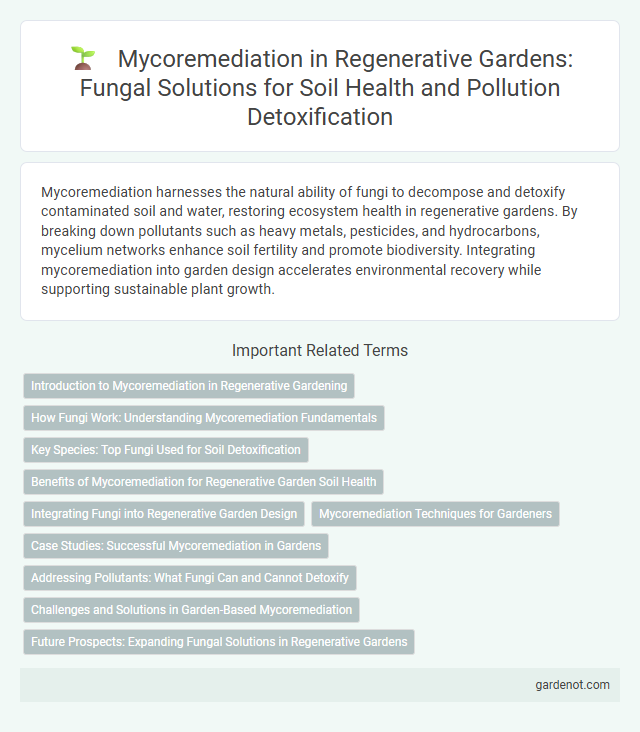Mycoremediation harnesses the natural ability of fungi to decompose and detoxify contaminated soil and water, restoring ecosystem health in regenerative gardens. By breaking down pollutants such as heavy metals, pesticides, and hydrocarbons, mycelium networks enhance soil fertility and promote biodiversity. Integrating mycoremediation into garden design accelerates environmental recovery while supporting sustainable plant growth.
Introduction to Mycoremediation in Regenerative Gardening
Mycoremediation in regenerative gardening harnesses fungi's natural ability to break down toxins and restore soil health. This eco-friendly technique accelerates decomposition of organic waste and heavy metals, improving nutrient cycles and promoting sustainable plant growth. Integrating fungi like oyster mushrooms enhances biodiversity while detoxifying contaminated environments in gardens and landscapes.
How Fungi Work: Understanding Mycoremediation Fundamentals
Fungi play a critical role in mycoremediation by breaking down complex organic pollutants through enzymatic processes that decompose toxic substances into harmless byproducts. Their mycelium network extends underground, secreting extracellular enzymes such as laccases and peroxidases that degrade contaminants like petroleum hydrocarbons, pesticides, and heavy metals. This natural biodegradation mechanism accelerates soil detoxification, making fungi essential agents in regenerative garden ecosystems focused on restoring soil health and biodiversity.
Key Species: Top Fungi Used for Soil Detoxification
Mycoremediation harnesses fungi such as Pleurotus ostreatus (oyster mushroom), Trametes versicolor (turkey tail), and Phanerochaete chrysosporium (white rot fungus) for effective soil detoxification. These species excel at breaking down pollutants like petroleum hydrocarbons, heavy metals, and pesticides through enzymatic degradation. Their application in regenerative gardens enhances soil health by restoring nutrient cycles and reducing toxic contamination levels.
Benefits of Mycoremediation for Regenerative Garden Soil Health
Mycoremediation harnesses fungi to break down contaminants and toxic substances in soil, enhancing regenerative garden soil health by restoring natural nutrient cycles. Fungal networks improve soil structure and increase organic matter decomposition, leading to richer, more fertile soil that supports diverse plant growth. This method also promotes sustainable soil remediation without harmful chemicals, preserving ecosystem balance and boosting long-term garden productivity.
Integrating Fungi into Regenerative Garden Design
Integrating fungi through mycoremediation in regenerative garden design enhances soil health by breaking down organic pollutants and improving nutrient cycling. Fungal networks increase soil biodiversity and support plant growth by establishing symbiotic relationships with roots, promoting resilience against pests and environmental stressors. Utilizing species such as oyster mushrooms (Pleurotus ostreatus) in garden beds accelerates decomposition processes, creating a sustainable and self-renewing ecosystem.
Mycoremediation Techniques for Gardeners
Mycoremediation techniques for gardeners utilize fungi to break down organic pollutants, enriching soil health and promoting plant growth. By applying fungal mycelium to contaminated garden areas, toxins such as pesticides and heavy metals are naturally degraded, restoring soil fertility. Integrating mycoremediation supports sustainable gardening practices through enhanced biodegradation and improved ecosystem resilience.
Case Studies: Successful Mycoremediation in Gardens
Mycoremediation has demonstrated significant success in regenerative garden settings by using fungi to break down contaminants like petroleum hydrocarbons and heavy metals. Case studies reveal fungi such as Pleurotus ostreatus effectively degrading soil pollutants, restoring plant health and biodiversity within months. These successful applications highlight fungi's potential to enhance soil quality and promote sustainable garden ecosystems.
Addressing Pollutants: What Fungi Can and Cannot Detoxify
Mycoremediation utilizes fungi's natural enzymatic processes to break down complex pollutants such as hydrocarbons, pesticides, and heavy metals in contaminated soil. Species like white-rot fungi effectively degrade persistent organic pollutants by producing ligninolytic enzymes, but they have limited ability to neutralize inorganic contaminants like radioactive isotopes or highly concentrated heavy metals. Understanding fungi's specific detoxification capabilities enables targeted application in regenerative gardens, enhancing soil health by reducing organic toxins while acknowledging their limitations with certain pollutants.
Challenges and Solutions in Garden-Based Mycoremediation
Garden-based mycoremediation faces challenges such as limited fungal species compatibility with native soils and fluctuating environmental conditions that hinder mycelium growth. Solutions involve selecting resilient, locally adapted fungi strains and optimizing soil amendments to enhance nutrient availability and moisture retention. Integration of biochar and organic compost improves fungal colonization while monitoring soil pH and temperature ensures effective pollutant degradation.
Future Prospects: Expanding Fungal Solutions in Regenerative Gardens
Mycoremediation offers promising future prospects for regenerative gardens by harnessing fungi's natural ability to break down pollutants and enhance soil health. Expanding fungal applications can improve nutrient cycling, detoxify contaminants, and promote biodiversity in garden ecosystems. Integrating diverse fungal species into garden design supports sustainable land restoration and resilient plant growth.
Mycoremediation Infographic

 gardenot.com
gardenot.com